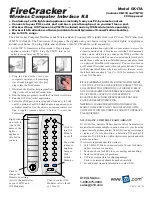
Model S4000T
41
9.0 Appendix
9.1 Principle of Operation
General Monitors uses a proprietary Metal Oxide Semiconductor (MOS) film on the
sensor for detecting Hydrogen Sulfide (H
2
S) gas. The MOS film is deposited onto a
substrate between two electrodes. With no gas present, the measured resistance
between these two electrodes is very high (in the mega-ohms). As H
2
S adsorbs onto
the film, the resistance between the two electrodes decreases (to kilo-ohms). This
decrease in resistance is logarithmically proportional to the concentration of H
2
S that
is present.
The change in resistance is converted to a change in voltage, and amplified by the
input circuit. This amplified signal is fed to an Analog to Digital (A/D) Converter,
converted to a digital signal and sent to the microprocessor to be processed. The
process of H
2
S adsorbing onto the MOS film is most effective at an elevated
temperature. On the outer edge of the substrate is a heater ring. The temperature of
this heater ring is measured with a thermistor, and kept constant by a circuit located
inside the body of the sensor.
As H
2
S adsorbs onto the film, electrons move more freely from one electrode to the
other. This is represented as a decrease in resistance. The process of H
2
S adsorbing
onto the MOS film is completely reversible. As the concentration of H
2
S decreases
(H
2
S desorbs), the resistance between the electrodes will increase.
9.2 Specifications
9.2.1 System Specifications
Sensor Type:
Continuous diffusion, adsorption type Metal Oxide
Semiconductor (MOS)
Sensor Life:
3 to 5 years typical
Repeatability:
+2 ppm or 10% of the applied gas, whichever is greater
Response Time:
T50<1 minute (screen)
T50<2 minutes (sintered) with full scale gas applied
Measuring
Ranges:
0-20 ppm, 0-50 ppm, 0-100 ppm
Modes:
Calibration, gas check, setup
Electrical
Classification:
CSA/FM:
Class I, Division 1, Groups B, C, D and Class I, Zone 1, Ex d
IIB+H
2
, T6.
CENELEC:
EEx d IIB, T5 and T6.
Warranty:
Two
years





































